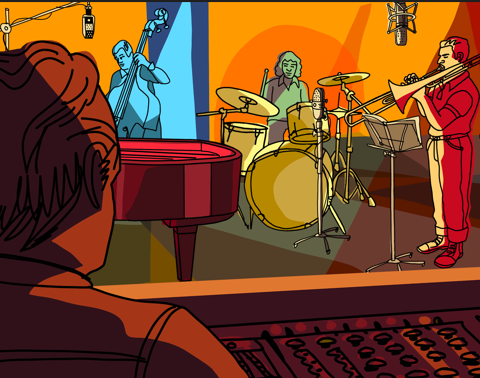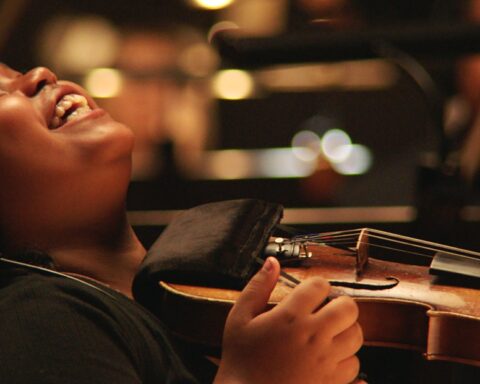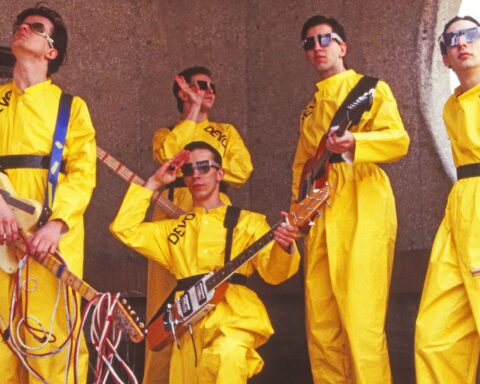Writing a piece about Phil Strong, the film score composer, would be wholly incomplete without including his life partner, Laurel MacDonald. Each is a professional musician with a distinct style but in many projects they end up blending together to create a unified output. They characterize the other’s music in telling ways. MacDonald describes Strong’s music as “guitar driven ambient electronica,” while Strong calls MacDonald’s style “Steve Reich meets the Swingle Singers.”
Strong has always been involved in music but never thought that he would end up making a career of it. He studied science at University of Western Ontario where, one summer, working as a student painter, he developed a skin condition on his hands. A friend’s mother suggested he consult the local diagnostician. After a fifteen-minute discussion about where Strong’s career path was leading him, the professional made his assessment: “I could give you a topical solution but I think you should think about music.” That was the first time Strong had been confronted with a non-allopathic solution to his physical ailments. Disgruntled and stunned, he left. While driving home he heard a radio ad for Trebas recording school. It was a moment that caused a great epiphany. Strong went to Trebas, eventually studied recording at Ryerson, and ended up at the Banff Centre, essentially living a “crash course” in everything there is to know about audio and sound for other artists’ projects.
Strong modestly sees himself “more as an engineer working with composing and sound design surrounding those core skills.” He’s more comfortable with the title of problem-solver than film score composer. Nonetheless, Strong’s “Philmography” counts twenty-six films. He and MacDonald also work extensively on dance films; video, for dance and theatre productions; and create/produce sound installations, including the current John Oswald 24-hour, 20,000 piece soundscape installed in the Royal Ontario Museum’s Spirit House.
Strong describes MacDonald as “the real musician in the family.” Also multi-talented, MacDonald has a professional singing career, composes her own material, sings with a number of choirs, does session recordings of other artists’ work, produces, conducts, and often collaborates with Strong on a wide variety of projects. MacDonald also came to music as a career choice later in life. She grew up in Nova Scotia without any formal training, and was “just a girl with a guitar doing singer song-writer things.” She pursued art history, architecture, and decorative arts at Dalhousie, and ended up working in the commercial photography business. She had a “quarter-life crisis,” pushing 30, she asked herself, “Is that what I’m still going to be doing when I turn 50?” MacDonald ultimately decided it was time to “find out what really makes me tick. That led me to music. Music is really what always made me feel wonderful when I was a kid.”
Strong met MacDonald, his life partner of fifteen years, serendipitously. The guy who took over from Strong at Banff had been scheduled to do some work for her. Strong ended up subbing in. By the time the two met in 1993, MacDonald was working on her third or fourth film score. Their first soundtrack collaboration was a project that MacDonald had been commissioned to do—a half-hour TV drama called Siblings. It was the first time MacDonald had the budget to hire someone to help out.
Talking to these two multi-talented artists in terms of collaborative process, one gets the impression that they work very organically, even though the “systems person” in Strong originally thought otherwise.“I had the idea that there is a prescribed pattern of how to do this work. [Now] I feel that every project is unique in its demands regarding the kind of things that the directors are looking for; [it can be] original music or music that is recreated, an existing composition, maybe a pop song, or underscore or overscore type of music.”
Overscore music is where the action is set to the score and the music is front and centre. The two have created an usually high percentage of overscore music. One project that forced them to develop a “creation methodology” was an NFB film about the lives of people who prioritize skiing above all else. ski bums is John Zaritsky’s feature-length documentary done in the style of a ski film. Strong explains that this is a genre unto its own. “Generally what happens in a ski film is they pick a genre of music, choose metal-edged pop and they cut the video to the music.” The project landed in MacDonald’s lap with “temped in” pop music. The music producer was after a very specific quality of voice that she recognized in MacDonald’s work. The project also required a lot of straight ahead rhythmic pop, world fusion and multiple textures. They had two weeks. MacDonald brought Strong on board and they worked out their method: “We sat down with the music supervisor and the editor and marked out all the places where they wanted music— what kinds and what themes were going to be mirrored—and we colour-coded all the themes. We went home and Laurel said ‘I’m going to start on all the pink, brown, and blue ones’ and I did all the green, orange, and red ones. We worked like that. We just created our pieces in our own ways. Laurel works with singing, building up tracks with her voice, and I work with guitar, drums and bass and that sort of thing, and then we switched.” MacDonald describes the process as essentially trading lives, “We both work alone, each individually working on cues, sketching out the initial ideas. Then we trade, and I’ll take his cues and start adding some vocal, and then Phil would tend to add bed tracks and create more structure.”
Strong prefers to temp everything out with sampled instruments, get approval on the idea of the pieces and then finalize the compositions, and have the musicians come in and record the parts—in that particular sequence. You can’t always have what you want. Strong’s most recent project, David Adkin’s documentary, Debt Trap, was another extremely tight turnaround. Strong had four days from delivery of picture to the mix. Strong suggested that he get involved at an early stage to avoid “tempitis”—a condition he describes as setting in when the director becomes wedded to the temp music and can’t open themselves to other possibilities. “I had to figure out a way to get approval of a lot of music before I had the picture. I had a rough edit to work with. I recorded musicians doing a bunch of variations of what I thought might happen, and basically, when I got the picture, I edited the music to fit.”
Strong and MacDonald came to Brenda Longfellow’s recent feature documentary, Weather Report, at a point where Longfellow was admittedly strongly attached to the temp music she had lived with for several months. At first, the process wasn’t the smoothest of rides for either party; however, they were thrilled with the outcome of their work together. Strong believes that in the beginning “wepushed it a bit farther away from home base than [Longfellow] was comfortable with, and so we just narrowed the gap.” At one point the gap got dangerously close to replicating what was there but ultimately they reached what both sides call “a point of confidence.” The critical element of trust between director and musician was established, and they were then able to push boundaries together and arrive in tandem at a successful destination.
So far Strong’s film score career has centered primarily around the doc world. Su Rynard’s dramatic feature Kardia counts as their sole contribution to the genre to date. Strong feels that, “In a drama you want to amplify what you’re seeing. But I feel that in documentary, I’m pulling the drama and evening it out so that the highly emotional sequences and the lesser emotional sequences have an even tone.”
When Ali Kazimi’s Continuous Journey (2004) reached Strong, it had a lot of what the composer would characterize as “very dramatic” temp music. “I thought it needed a calmer underpinning. What we’re seeing is very dramatic, and I think my sense of what a doc should be is really on a more even keel.” Strong counts his and MacDonald’s collaboration with filmmaker Ali Kazimi as a high point in their career. Continuous Journey garnered the musicians a Golden Sheaf and Gemini nomination for best music and sound. What stood out for both musicians was the degree to which the director was involved in bringing in other co-creative musicians to the project. Kazimi introduced Strong and MacDonald to then Toronto-based ghazal singer, Kiran Ahluwalia and qawwali singer, Shaheed Ali Khan. They also worked with tabla player, Ravi Naimpally and percussionist Ben Grossman. Another “luxury” on this film was the seemingly open-ended time line. “We were just working on this film. It had to be done before the film went bank- rupt. That’s pretty unique for a film of that calibre.” The other somewhat unique set of circumstances was the fact that Strong was responsible for both the music score and the sound design. “Normally you get to a mix and there’s sound from beginning to end and there’s music from beginning to end. When we went to our mix, we had none of those battles to resolve. The mix was really just getting the levels suitable for broadcast.”
Strong and MacDonald live by the dictum, “variety is the spice of life.” They claim to have never done two similar projects in a row, moving fluidly from dance music to television, to theatre projects and sound installations. Their chameleon-like skills have yielded positive economic spin-offs. By choosing not to do TV series work (reportedly where all the bread-and-butter money is to be made) they have the combined tool kit to be responsive to the shifting and growing demands of the independent marketplace. Strong appreciates their multiplicity. “We are a really good team because we have different specialties. We can do different things at the same time. We can cover a lot of ground between the two of us … Part of what I really like about the way our lives have come together is the diversity—the variety. I feel like we’re always studying, and learning new things.”











